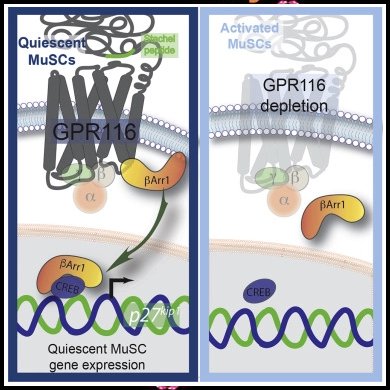The adhesion G-protein-coupled receptor Gpr116 is essential to maintain the skeletal muscle stem cell pool.
• Quiescent muscle stem cells express the adhesion G-protein-coupled receptor Gpr116
• Gpr116-deficient muscle stem cells are incapable of maintaining quiescence
• The GPR116 Stachel agonist peptide prevents MuSC activation
• GPR116 signaling is mediated in part by nuclear activity of β-arrestin1

Skeletal muscle is populated with a reservoir of quiescent muscle stem cells (MuSCs), which regenerate the tissue after injury. Here, we show that the adhesion G-protein-coupled receptor Gpr116 is essential for long-term maintenance of the MuSC pool. Quiescent MuSCs express high levels of Gpr116, which is rapidly downregulated upon MuSC activation. MuSCs deficient for Gpr116 exhibit progressive depletion over time and are defective in self-renewal. Adhesion G-protein-coupled receptors contain an agonistic peptide sequence, called the “Stachel” sequence, within their long N-terminal ectodomains. Stimulation of MuSCs with the GPR116 Stachel peptide delays MuSC activation and differentiation. Stachel peptide stimulation of GPR116 leads to strong interaction with β-arrestins. Stimulation of GPR116 increases the nuclear localization of β-arrestin1, where it interacts with cAMP response element binding protein to regulate gene expression. Altogether, we propose a model by which GPR116 maintains the MuSC pool via nuclear functions of β-arrestin1.
→
Cell Reports Volume 41, ISSUE 7, 111645, November 15, 2022
https://doi.org/10.1016/j.celrep.2022.111645
→ Research Outline (PDF In Japanese language)